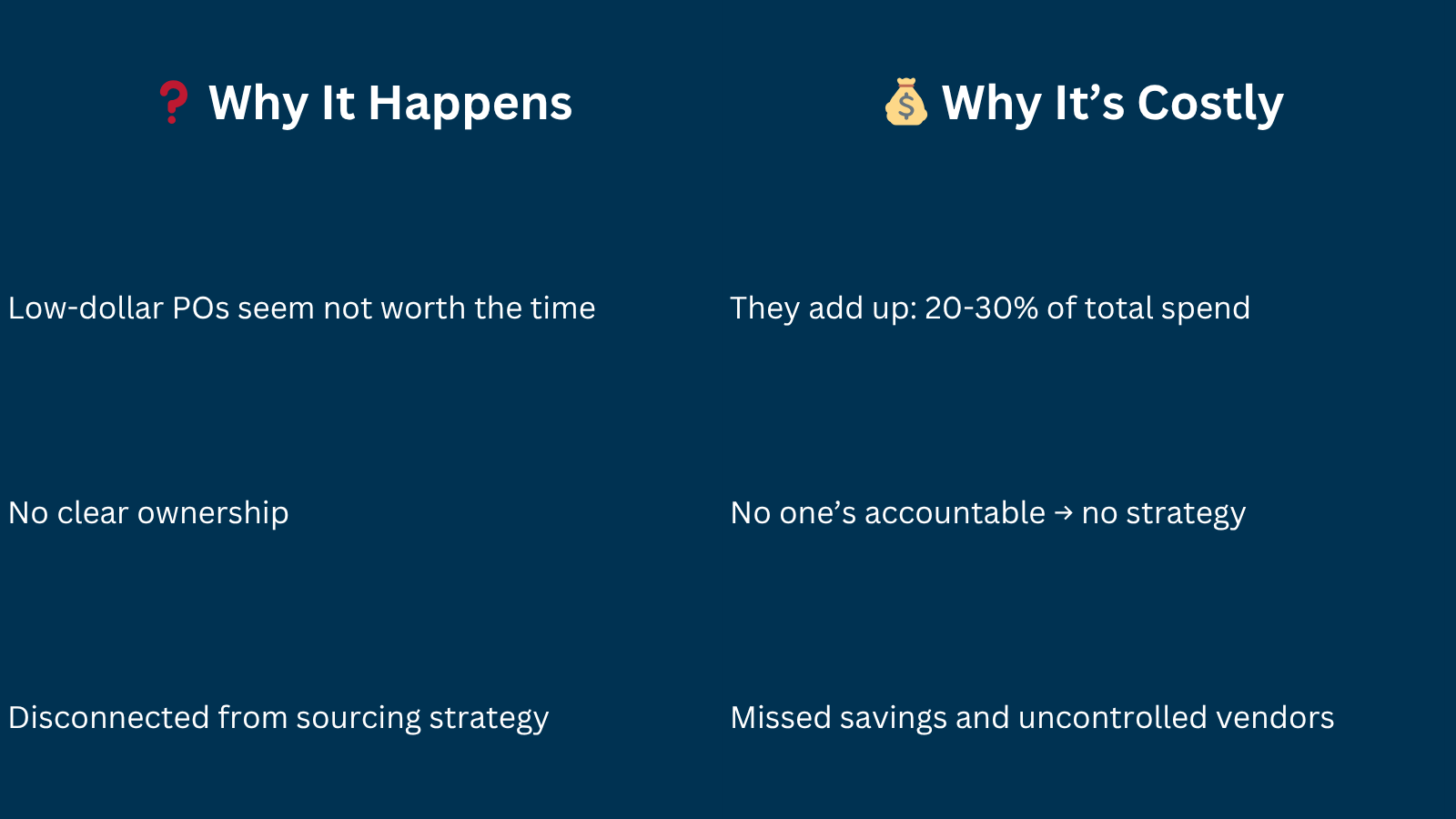Top 5 Mistakes in Tail Spend Procurement (And How to Fix Them)
Small Purchases. Big Problems. The Tail Is Costing You More Than You Think.

Tail spend in MRO isn’t usually top of mind.
It’s decentralized, low value, and outside of contract strategy.
But here’s what we see again and again:
Procurement teams focus on strategic sourcing, while the tail becomes a mess of inefficiency, risk, and hidden cost.
What starts as tactical buying becomes a systemic margin leak.
This article exposes the 5 most common mistakes teams make with MRO tail spend – and how to fix them with visibility, data, and AI-powered control.
In This Guide:
- What’s actually going wrong with tail spend (beyond what dashboards show)
- How traditional procurement processes make it worse
- Tactical fixes that don’t require organizational disruption
- How AI closes the gap without adding complexity
Mistake #1: Assuming Tail Spend Isn’t Worth Managing
Tail spend feels small. So it’s left untouched. But it’s not just about transaction size – it’s about scale and fragmentation.

Fix: Start by identifying volume patterns – not value. AI can cluster tail transactions into actionable groupings.
Mistake #2: Letting Sites Pick Their Own Vendors
When plants are left to source “what they need” on the fly, you get:
- Vendor sprawl
- Lost leverage
- Supplier compliance risk
One enterprise Verusen assessed had 33 different vendors for identical fasteners – all approved locally.
Fix: Use AI to identify similar parts and vendors. Consolidate tail items into contracts with preferred suppliers – while giving sites flexibility within those rails.

Mistake #3: Thinking Cleansing Your Data Once Will Solve It
Many teams invest in massive taxonomy and data cleanup efforts. The result?
- New POs start creating duplication within weeks
- Suppliers get recreated with alternate IDs
- Parts are ordered outside category rules again
Fix: Adopt a continuous unification layer – like Verusen – that maps and monitors part duplication and vendor overlap as it happens, not once a year.
Mistake #4: Chasing the Lowest Price – Every Time
Price hunting in the tail feels like savings – but it creates:
- Long-term TCO increase (non-standard parts = more stock)
- Delayed deliveries
- Inconsistent warranty and support
Plus, it burns time. Every RFQ for a $12 gasket costs your team far more than it saves.
Fix: Automate tail transactions through strategic bundling or preferred vendor coverage. Use AI to flag savings in context of total lifecycle value.
Mistake #5: Treating Tail Spend Like Core Spend
Most procurement systems, processes, and policies are built for strategic categories. Tail doesn’t fit the model – so it falls between the cracks.
Result?
Compliance tracking fails.
Contractual non-compliance grows.
The CPO has no visibility into 25% of their spend.
Fix: Create a tail-specific strategy that includes:
- AI categorization of transactions
- Guardrails for buyers, not barriers
- Consolidation triggers based on data, not policy
CASE SNAPSHOT: From Tail Chaos to Strategic Control
Company: Multinational Chemical Manufacturer
Challenge:
- 6,000+ suppliers
- Inconsistent tail governance
- Duplicate materials across plants
Action:
- Implemented Verusen AI
- Identified top 20% tail categories for consolidation
- Flagged 14% of tail suppliers as redundant
Results:
- $3.8M in managed savings
- 2x increase in contract compliance
- Faster purchasing cycles with fewer RFQs
Bonus: Your Tail Spend Audit Starter Questions
- Which vendors have <0.1% of total spend?
- Are identical parts being purchased under different names or suppliers?
- What % of tail transactions are going through RFQ cycles?
- How many POs per vendor are <$1,000?
- What is our cost per tail PO?
FAQs
We already did a tail spend cleanse – why is this still a problem?
Because tail is dynamic. Without continuous visibility, it creeps right back in.
Can we fix this without forcing every plant into the same vendor?
Yes. The goal is guided autonomy – not top-down restrictions. AI makes this scalable.
How long until we see results?
Initial tail diagnostics show actionable results in 2-4 weeks.
Ready to Clean Up the Quiet Chaos?
Tail spend doesn’t have to be a mess.
You just need visibility, pattern detection, and a system that learns with you.→ Book a Tail Spend Audit (Free)

